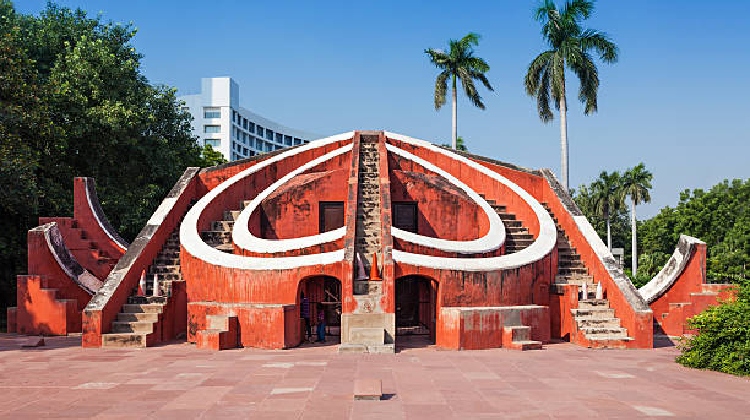Unraveling the Mysteries of Jantar Mantar, Delhi: A Journey Through Time
Jantar Mantar Delhi is a fascinating astronomical observatory stands as a testament to India’s scientific prowess during the 18th century. Located in the heart of New Delhi this remarkable site is a significant attraction in New Delhi for both tourists and scholars alike. It showcases the astronomical advancements of its time and continues to captivate visitors with its intriguing design and historical importance. View Below For Jantar Mantar Attraction or Jantar Mantar History.

Traveller Information
- Location Parliament Street/Sansad Marg, Connaught Place Delhi, India
- Reach There Metro (Patel Chowk Metro Station)
- Entry Fee Indian/foreigner 15/150, Video 25
- Visiting Time 10 AM to 6 PM (on all days of the week)
History of Jantar Mantar
The Jantar Mantar History is deeply rooted in the scientific ambitions of Maharaja Jai Singh II of Jaipur. Built in 1724 this observatory was part of a series of five such structures erected in different cities, including Jaipur, Ujjain, Varanasi and Mathura. Jai Singh II, an avid astronomer and mathematician constructed these observatories to refine the existing astronomical tables and to better understand celestial movements.
Purpose and Construction
The primary purpose of the Jantar Mantar Delhi was to observe and predict the movements of the sun, moon and planets. Jai Singh II employed a blend of traditional Indian astronomy and contemporary European techniques resulting in a unique architectural style that is both functional and aesthetically pleasing. The observatory consists of 13 architectural astronomy instruments each serving a specific purpose in the study of celestial bodies.
Architectural Marvels of Jantar Mantar
The Jantar Mantar Delhi is renowned for its architectural ingenuity. The instruments, made of brick and plaster, are designed with precision to measure time, predict eclipses, and track stars’ locations. Among these instruments, three stand out for their size and significance.
Samrat Yantra
The Samrat Yantra is the largest instrument in Jantar Mantar. It is a gigantic sundial with a 27-meter-high gnomon, casting a shadow that moves visibly at 1 mm per second, allowing precise time measurements. This instrument also aids in determining the declination of celestial bodies.
Jaiprakash Yantra
The Jaiprakash Yantra consists of two concave hemispherical structures with marked marble slabs. This instrument helps in determining the position of celestial objects by aligning the view with these markings.
Misra Yantra
The Misra Yantra is a unique instrument used to determine the shortest and longest days of the year. It is also used to ascertain the exact moment of noon in various cities regardless of their geographical location.
Cultural and Scientific Importance
Jantar Mantar Delhi holds significant cultural and scientific value. It is not only an architectural wonder but also a monument to India’s rich history in astronomy. The observatory represents a time when India was at the forefront of scientific research, and it continues to inspire awe and curiosity among visitors.
Role in Scientific Advancement
During the 18th century, the Jantar Mantar Delhi played a crucial role in advancing astronomical knowledge. The precise measurements and observations made here contributed to a better understanding of celestial mechanics, influencing both Indian and European astronomy.
Visiting Jantar Mantar Delhi
For those planning to visit this extraordinary site, Jantar Mantar Delhi is open to visitors throughout the year. Located near Connaught Place, one of Delhi’s busiest commercial areas, it is easily accessible by various modes of transport.
How to Reach Jantar Mantar
The nearest metro station to Jantar Mantar Delhi is Rajiv Chowk, from where the observatory is just a short walk. Visitors can also hire taxis or auto-rickshaws to reach the site. The surrounding area is vibrant with shops, restaurants, and other attractions, making it a convenient stop for tourists.
Nearby Attractions
While visiting Jantar Mantar, there are several other attractions nearby that are worth exploring. Connaught Place, with its colonial architecture and bustling markets, offers a blend of modern and historical experiences. Additionally, the India Gate and Rashtrapati Bhavan are not far from Jantar Mantar, providing a glimpse into India’s political and cultural heritage.
Conclusion
The Jantar Mantar Delhi stands as a remarkable fusion of science, architecture, and history. Its innovative design and historical importance make it a must-visit attraction in New Delhi. As we delve into the history of Jantar Mantar and its role in astronomical advancements, we gain a deeper appreciation for this extraordinary observatory and its enduring legacy.




